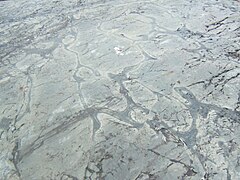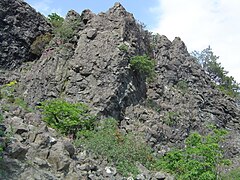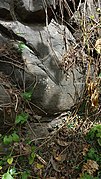Pillow lava

Pillow lavas are lavas that contain characteristic pillow-shaped structures that are attributed to the extrusion of the lava underwater, or subaqueous extrusion. Pillow lavas in volcanic rock are characterized by thick sequences of discontinuous pillow-shaped masses, commonly up to one meter in diameter. They form the upper part of Layer 2 of normal oceanic crust.
Composition

Pillow lavas are commonly of
Occurrence
They occur wherever lava is extruded underwater, such as along marine
The presence of pillow lavas in the oldest preserved volcanic sequences on the planet, the
Pillow lavas are also found associated with some subglacial volcanoes at an early stage of an eruption.[6][7]
Formation
They are created when
Use as a way-up criterion
Pillow lavas can be used as a way-up indicator in geology;[9] that is, study of their shape reveals the attitude, or position, in which they were originally formed. Pillow lava shows it is still in its original orientation when:
- Vesicles are found towards the top of a pillow (because the gas trapped as part of the rock is less dense than its solid surroundings).
- The pillow structures show a convex (rounded) upper surface.
- The pillows might have a tapered base downwards, as they may have molded themselves to any underlying pillows during their formation.
Gallery
-
Pillow lava near Oamaru, New Zealand
-
Weathered Archean pillow lava in the Temagami Greenstone Belt of the Canadian Shield
-
Pillow lava formations from anApennines, Italy
-
Pillow basalt from Baras, Rizal Province, Philippines
See also
- Pillow basalt
- Spilite, a fine-grained igneous rock, resulting particularly from the alteration of oceanic basalt
References
- ^ "McCarthy, T. & Rubidge, B. 2008. The story of earth and life, Chapter 3, The first continent. 60-91, Struik Publishers" (PDF). Web.wits.ac.za. Archived from the original (PDF) on 2009-04-07. Retrieved 2014-03-10.
- .
- S2CID 128613176.
- S2CID 129797887.
- ISBN 978-0-8137-2265-8.
- ^ Geology and geodynamics of Iceland, R.G. Trønnes, Nordic volcanological Institute, University of Iceland
- ^ "Scientists Study 'Glaciovolcanoes,' Mountains of Fire and Ice, in Iceland, British Columbia, US ScienceDaily, Apr. 23, 2010". Sciencedaily.com. Retrieved 2014-03-10.
- ^ 2005. Volcanoes and the environment by Joan Martí, Gerald Ernst, Cambridge University Press, 488 pp.
- ^ H. Furnes and F. J. Skjerlie (1972-07-01). "Furnes, H. & Skjerlie, F.J. 1972. The significance of primary structures in the Ordovician pillow lava sequence of Western Norway in an understanding of major fold pattern. Geological Magazine, 109, 315-322". Geolmag.geoscienceworld.org. Retrieved 2014-03-10.




